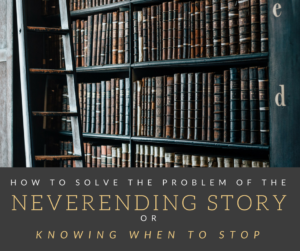Concise writing, or, solving the problem of the NeverEnding Story
Not Just for Kids from the Eighties
Back in 1984, a film called The NeverEnding Story was released. Based loosely on a book of the same name, it was notable for a furry white dragon that looked like a dog and a song which seems to have consisted only of the words “Ooooh, NeverEnding Storyyyyyyyy”. My sisters, brother and I loved this film and all that it represented. I haven’t seen it for years, afraid that exposure to modern special effects will destroy my nostalgia for this piece of 80’s low-brow culture.

Want to write more concisely?
Struggling to write concisely is a genuine problem. However, if you look at content development advice, you’d think it wasn’t an issue. There are so many tips and posts about avoiding writer’s block and developing content ideas. Entire businesses devote themselves to the cause. But although it can be tough to get started with your writing, finishing it can be even tougher.
But fear not. Simple solutions exist, and cheerfully they’re easier than hopping on the back of a dubious-looking dragon (sorry, that’s one for the Never Ending Story fans…).
It’s simply a matter of good planning. Remember, writing for your audience is no more than writing a very simple story. You need a beginning, a middle and an end. One of the simplest ways to write this simple story is simply to:
- Tell your audience what you’re going to say (the beginning)
- Tell them what they want to know / need to know (the middle)
- Remind them of the salient points / tell them the conclusion (the end)
And wouldn’t you know, it’s the middle bit where the problems happen. Where extra ideas arrive and explanations exceed their allotted allowance. Where the story you’re telling starts to move towards the dreaded “NeverEnding Story” territory.
Help yourself to some prompts to keep out of this no-man’s land of tumbleweed and literary durchfall (it’s German; so much more expressive than the English equivalent, and easier to spell).
Five Perfect Prompts to Keep Your Storytelling on Track.
1. Make a Plan.

There’s no plan like a good plan
I know, if I’ve said it once, I’ve said it a thousand times. But a plan (even a very basic plan) is essential if you want your words to work for you. Think carefully about what you want your readers to do once they’ve finished reading. How do you want them to feel? What do you want them to believe? Make a plan, or even a simple checklist. Whatever works for you.
2. Stay on Course.
Great! You have your plan. But just as you wouldn’t set off on a journey without referring to your map or satnav again, make sure you regularly refer to your plan to be sure you’re staying on track and not veering off into an unplanned direction. This is essential if you want to write concisely.
3. Less is More.
It can be so difficult to keep your writing focused on just one or two concepts and metaphors. Trust me, I know; the more you write, the more ideas you have, and it seems like a waste of brainpower to not use those great ideas, even if they weren’t in your plan. My advice? Include those extra ideas in your first draft. Then edit them out by cutting and pasting into a different file (your “Genius Metaphors” or “Brilliant New Ideas” files).
Result? Your writing stays on track and you have a bundle of ideas to use on those days when inspiration is scarce.
4. Edit Yourself Out.
Remember, you’re writing for your reader. Not yourself. It can be too easy to write as if you’re making a personal diary. If your writing is too ambling, take stock and question how much of it is truly useful and interesting to your reader. Be brutal with yourself and delete anything that’s irrelevant and/or uninteresting. And if it’s interesting (and I mean, genuinely interesting) but not relevant, find a way to make it relevant to your reader.
5. It’s not Poetry.
To write concisely you need to keep things simple. Unless you’re specifically tasked with creating a sensorial or artistic approach (fashion and fragrance for instance), limit your use of adverbs and adjectives, and keep your metaphors simple. For copy that’s simpler to understand and less open to misinterpretation, focus your writing on the communication of an idea, rather than the expression of an emotion.
The End
And there we have it. With a neat and tidy middle part of your story, all that remains is to remind your reader of the salient points. Which in this case is to make a plan and stick to it. And if it’s proving too much, then call in the professionals. Give a copywriter (me for instance) a shout to help you lick that writing into shape. Without a furry dragon in sight.
Get in touch today and I’ll help you with your website writing woes and brochure planning blues.






